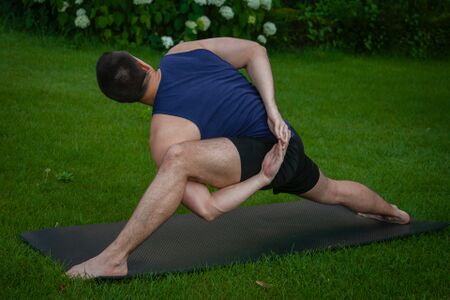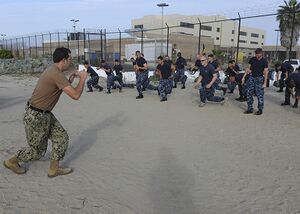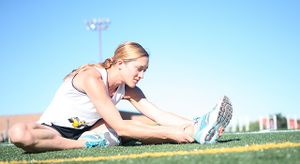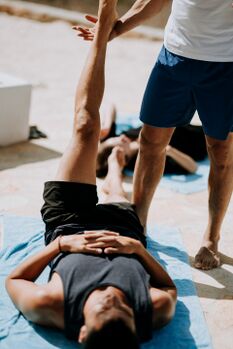Flexibility
Original Editor - Lucinda hampton
Top Contributors - Lucinda hampton, Anne Dixie Lim and Aminat Abolade
Introduction[edit | edit source]
General flexibility is a key component of health, well-being, and general physical conditioning. Reduced flexibility has both physical and mental/emotional etiologies and can lead to musculoskeletal injuries and athletic underperformance.[1]
Flexibility is operationally defined as “the intrinsic property of body tissues, including muscle and connective tissues that determines the range of motion achievable without injury at a joint or group of joints.” Flexibility is highly specific to each joint.
- Stretching exercises are typically performed to increase flexibility and to allow improved joint range of motion.
- Common forms of stretching include static stretch (passive and active), proprioceptive neuromuscular facilitation, ballistic stretch, and dynamic stretch. Other forms of physical activity that require stretching (e.g., gymnastics, dance) can also result in improved flexibility. [2]
Benefits of Flexibility[edit | edit source]
The ability to fully use one’s ROM plays a role in day-to-day activities (e.g., reaching, bending, turning) as well as athletic endeavors. Flexibility losses are may be brought to full attention when we eg can't put shoes on due to loss of hip, knee or spinal loss of range of movement with arthritis; have restricted ROM in the neck from sitting constantly hunched over a computer screen; loss of flexibility from the aging process. If people neglect to spend time focused on flexibility it can result in an avoidable loss of ROM. Flexibility exercises should be included as part of an overall exercise program as a proactive way to maintain, or even improve, ROM.
Image 2: A group of chief petty officers in dynamic stretching
Flexibility exercises used to improve ROM can take a number of forms, including the following:
- static stretching (stretch and then hold the final position for a given time)
- active static stretching (holding position by contraction of agonist muscle(s))
- passive static stretching (holding position with no involvement of agonist muscles, may use partner or stretching aid)
- dynamic stretching (stretch with slow movement; progressively increase the range of motion through repeated movements)
- proprioceptive neuromuscular facilitation (isometric contraction is followed by a static stretch)[3]
Dynamic VS Static Stretches[edit | edit source]
When preparing the muscles for action, eg swimming, running, you need to prepare your muscles with a warm ups that typically include stretching. So the question arises which gives better results static or dynamic stretches?
The stretching portion traditionally incorporated static stretching. However, there are a myriad of studies demonstrating static stretch-induced performance impairments. More recently, there are a substantial number of articles with no detrimental effects associated with prior static stretching[4]eg
- Dynamic stretching improves repeated-sprint performance to a greater extent than static stretching and no stretching[5]
- Immediately after a single bout of static stretching significant reductions in maximal voluntary strength, muscle power or evoked contractile properties have been recorded.[6]
- Active warm-ups encompassing such exercises as sprints and plyometrics can enhance power and strength performance. Meanwhile shorter, static stretching not only fails to provide such a boost, but may also reduce strength[7].
- A meta-analysis of 32 studies on warming up and performance in 2010 also found that doing an active warm-up before engaging in sports yields improved performance, in this case, by 79 percent across all criteria examined[7].
Older People[edit | edit source]
Flexibility training interventions in older adults are often effective at increasing joint range of motion in various joints, and various functional outcomes can be improved. However older adults are not overly concerned with high performance benefits from increased flexibility and more focused on being safely active and safely performing activities of daily living. Injury and fall prevention are also common motives for recommending flexibility programs to older adults. Flexibility training may enhance postural stability and balance when combined with resistance training.[8] See also Physical Activity in Older Adults
While there is a lack of evidence to recommend stretching routines outside of a rehabilitative context, there is no additional health or functional risk of including flexibility exercises. In light of increases in functional outcomes achieved by other exercise modes (balance, aerobic exercise, and strengthening exercises), stretching exercises can be included as an adjunct to the above, but the current literature would indicate it would add little to the functional benefits of the other exercise modes.[8]
Low Back Pain[edit | edit source]
Flexibility exercises are often used in exercise rehabilitation programmes as they have been shown to be effective at reducing the pain associated with non-specific chronic low back pain. See also Interventions for LBP
Stretching the soft tissues in the back, legs and buttock eg hamstrings, erector muscles of the spine and hip flexor muscles, ligaments and tendons can help to mobilise the spine, and an increase in the range of motion of the spine can reduce back pain. This is because stretching can improve the flexibility of the muscle-tendons and ligaments in the back, which is important to increase the range of motion of the joints. This improved range of motion assists with patients’ movement and ability to complete activities of daily living, as most everyday tasks such as lifting and bending require trunk flexion, which involves a complex movement combining lumbar and hip motion[9].
Final Remarks[edit | edit source]
Flexibility exercises are recommended as part of a complete exercise program along with cardiorespiratory exercise, resistance training, and neuromotor exercise training.
- Chronic improvements in ROM are possible with a regular stretching program, concerns have been raised related to the acute impact of stretching on subsequent strength and power performance.
- As yet not definitive but shifting stretching exercises from preactivity to postactivity may be an option to consider, or including flexibility exercises as a stand-alone program to reap the benefits of chronic adaptations.[3]
- bulleted list
- x
or
- numbered list
- x
References[edit | edit source]
- ↑ Jensen AM, Ramasamy A, Hall MW. Improving General Flexibility with a Mind-Body Approach: A Randomized, Controlled Trial Using Neuro Emotional Technique®. The Journal of Strength & Conditioning Research. 2012 Aug 1;26(8):2103-12. Available:https://pubmed.ncbi.nlm.nih.gov/22814766/ (accessed 24.12.2021)
- ↑ Pate R, Oria M, Pillsbury L. Health-related fitness measures for youth: flexibility. InFitness Measures and Health Outcomes in Youth 2012 Dec 10. National Academies Press (US). Available:https://www.ncbi.nlm.nih.gov/books/NBK241323/ (accessed 24.12.2021)
- ↑ 3.0 3.1 Health and fitness journal Flexibility Exercises and Performance Available: https://journals.lww.com/acsm-healthfitness/Fulltext/2016/09000/Flexibility_Exercises_and_Performance.4.aspx(accessed 24.12.2021)
- ↑ Behm DG, Chaouachi A. A review of the acute effects of static and dynamic stretching on performance. European journal of applied physiology. 2011 Nov;111(11):2633-51.Available:https://www.researchgate.net/publication/50272304_A_review_of_the_acute_effects_of_static_and_dynamic_stretching_on_performance (accessed 24.12.2021)
- ↑ Zmijewski P, Lipinska P, Czajkowska A, Mróz A, Kapuściński P, Mazurek K. Acute Effects of a Static Vs. a Dynamic Stretching Warm-up on Repeated-Sprint Performance in Female Handball Players. Journal of human kinetics. 2020 Mar;72:161.Available:https://www.ncbi.nlm.nih.gov/pmc/articles/PMC7126248/ (accessed 24.12.2021)
- ↑ Opplert J, Babault N. Acute effects of dynamic stretching on muscle flexibility and performance: an analysis of the current literature. Sports Medicine. 2018 Feb;48(2):299-325.Available: https://pubmed.ncbi.nlm.nih.gov/29063454/ (accessed 24.12.2021)
- ↑ 7.0 7.1 Open fit Dynamic vs Static stretching Available: https://www.openfit.com/dynamic-vs-static-stretching-warm-up-exercises(accessed 24.12.2021)
- ↑ 8.0 8.1 Stathokostas L, Little R, Vandervoort AA, Paterson DH. Flexibility training and functional ability in older adults: a systematic review. Journal of aging research. 2012 Nov 8;2012.Available:https://www.ncbi.nlm.nih.gov/pmc/articles/PMC3503322/ (accessed25.12.2021)
- ↑ Gordon R, Bloxham S. A systematic review of the effects of exercise and physical activity on non-specific chronic low back pain. InHealthcare 2016 Jun (Vol. 4, No. 2, p. 22). Multidisciplinary Digital Publishing Institute. Available: https://www.ncbi.nlm.nih.gov/pmc/articles/PMC4934575/(accessed 25.12.2021)











